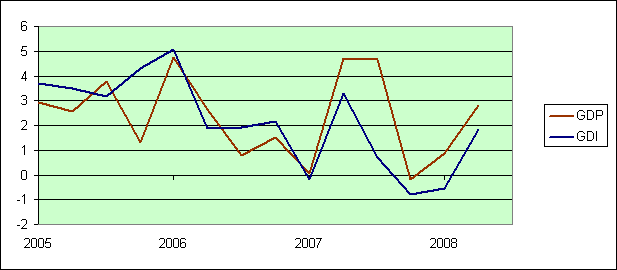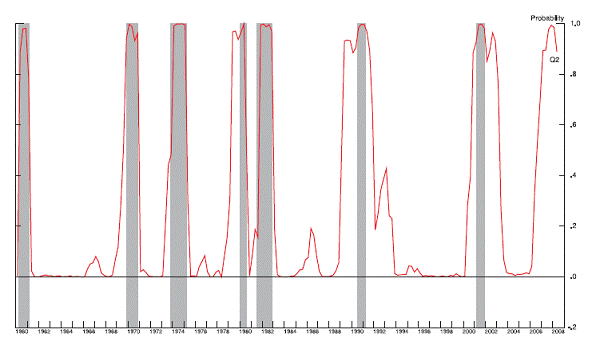The “final” values for 2008:Q2 GDP released by the Bureau of Economic Analysis on Friday were more disappointing than the earlier estimates. Still, the 2.8% annual growth rate for real GDP that we’re now told characterized the second quarter doesn’t sound like a recession. Or does it?
As we teach in any introductory macroeconomics course, it is possible to think of GDP in two different ways. One is as the dollar value of all final sales of goods and services produced by factors of production located within the United States. The second is as the dollar value of all the income generated by that production. The two measures are equal to each other by definition. But in practice, one can try to calculate GDP either using production data or using income data. If we obtain the production and income numbers from different sources, we’re certain to end up with different numbers for what is supposed to be the nation’s GDP. The difference between “gross domestic product” (GDP) and “gross domestic income” (GDI) is simply reported by the BEA as a “statistical discrepancy.”
| Quarter | GDP | GDI |
|---|---|---|
| 2007:Q4 | -0.2% | -0.8% |
| 2008:Q1 | +0.9% | -0.5% |
| 2008:Q2 | +2.8% | +1.8% |
Federal Reserve economist Jeremy Nalewaik has several research papers ([1], [2]) arguing that GDI may be a more helpful series for recognizing recessions than is GDP. It is interesting that while GDP indicates sluggish growth over the last 3 quarters, GDI looks much more like a recession, with 2007:Q4-2008:Q1 satisfying the traditional rule of thumb of two quarters of falling real output.

|
Jeremy has calculated recession probabilities similar to our
Econbrowser recession indicator index
using GDI in place of GDP. He has a slightly different approach to real-time versus revised data from the one we use, and bases parameter estimates on a sample beginning in 1959 rather than the 1947 starting point that we use. Using the later starting point causes his parameter estimates to imply slightly milder recessions on average than one would infer on the basis of the full data set, so his algorithm is a little more likely to indicate a recession for given slow or negative growth rates than would ours. But the biggest difference is the more sluggish recent behavior of GDI relative to GDP.
Jeremy was kind enough to prepare for me a plot of his recession probabilities calculated on the basis of GDI, displayed in the figure below. Note that this diagram follows the same rule as our index
(plotted here)–
the value of the index for any given date is calculated on the basis of the data as it was actually reported at the time. Jeremy’s index unambiguously signals that the U.S. economy is now in recession.

|
I’m not convinced that there’s a compelling basis for claiming that GDI is a better measure than GDP. But in this case, there’s another very important consideration. Measures of employment growth and the unemployment rate seem to be
signaling pretty strongly
that the U.S. is already in a recession, whereas the GDP numbers do not. Which should we believe? Given that one can reconcile the employment and GDP inferences entirely on the basis of the known numerical value for the statistical discrepancy in the GDP numbers, it seems like a pretty clear call to me– the U.S. economy is currently in a recession which likely began in the fourth quarter of last year.
There’s an important implication of this for the ongoing discussion of the current financial turmoil. The U.S. is currently in a recession, and events of the last two weeks are sure to make things worse for the next few months, even if we had some policy to bring immediate stability to financial markets. That is water under the bridge at this point.
The purpose of the
Paulson–Dodd
proposals
is thus not to prevent the economy from going into recession. The purpose is to prevent the recession from turning into a severe contraction.
Technorati Tags: GDP,
gross domestic product,
gross domestic income,
recession,
recession probability,
recession indicator index,
macroeconomics,
economics
Hey I’m glad you looked at this. I read about the GDI stuff a month or two back and so it’s good that there’s someone out there still examining it.
You point out that;
“Jeremy’s index unambiguously signals that the U.S. economy is now in recession.”
Actually that’s not so. It might be more accurate to say that Jeremy’s index unambiguously signals that the US was in recession, at the end of 2007 and beginning of 2008.
It would now appear that, based on this graph, the US is moving out of recession.
Bill J, the plotted probability is 0.9 for 2008:Q2. Given that we were in a recession in 2008:Q1, the sluggish growth for 2008:Q2 is going to be seen by the algorithm as a continuation of the recession.
Considering that: “The purpose of the Paulson-Dodd proposals is thus not to prevent the economy from going into recession. The purpose is to prevent the recession from turning into a severe contraction.”, why hasn’t the Fed Funds rate been lowered since April 30th?
The FOMC statement from Sept 16th seems to indicate that panel members see symmetrical risks between weak growth and accelerating inflation: “The downside risks to growth and the upside risks to inflation are both of significant concern to the Committee. The Committee will monitor economic and financial developments carefully and will act as needed to promote sustainable economic growth and price stability.” Isn’t that perspective at odds with Bernanke and Paulson telling us that Congress must act NOW to forestall financial armageddon?
This is the first financial crisis in my memory in which the fed funds rate has been left flat for FIVE MONTHS and the adjusted monetary base has been left to expand at a paltry +2%.
I wonder if a recession might actually be a good thing for the US economy. Assuming that GDP is a reasonable measure of welfare, surely what matters is the overall level of its future path, not whether that path happens to fall for a while. Assuming also that parts of the US economy are unsustainable – eg lots of realtors, mortgage brokers, retail workers etc – the overall loss of welfare might be better if the bust is not resisted and these parts just abruptly stop (albeit with some government transition assistance). I can appreciate that the politicians might not like the pain front-loaded, but what should the economists’ advice be?
It is often said that Japan made the mistake of not easing sufficiently aggressively and early. How many years of sluggish growth do we have to see in Japan before it might be concluded that Japan should have tried, say one year of 20% contraction, followed by a return to the pre-bust trend growth rate?
Anarchus – The FED Funds Rate doesn’t make any difference any more. Dropping the FFR will only increase the difference between commercial and interbank lending (the TED spread), and will further accentuate the dysfunction in the banking system. Banks are hesitant to loan to each other because so many are technically in violation of their reserve requirements, but survive by not marking their security assets to current market prices.
The FED is not actively increasing the monetary base for several reasons:
GDP can be skewed by changes in inventory for one.
Furthermore the order of goods is planned in advance (with the longest lead times for the biggest dollar goods), whereas changes in employment in terms of dollars is much more responsive to a present situation (whether it be cutback in hours, canceling of bonuses, etc)
Income is seldom awarded significantly before or after production, or if there is a time-delay it is consistent
Finally GDI is less blind to the second-hand or black markets. The used car salesman will report timely information with their income, while the production by the person buying the used car is a degree removed from actual market activity